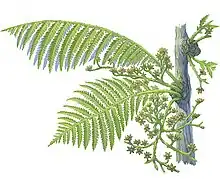Peltaspermales
The Peltaspermales are an extinct order of seed plants, often considered "seed ferns".[2] They span from the Late Carboniferous to the Early Jurassic. It includes at least one valid family, Peltaspermaceae, which spans from the Permian to Early Jurassic, which is typified by a group of plants with Lepidopteris leaves, Antevsia pollen-organs, and Peltaspermum ovulate organs, though the family now also includes other genera like Peltaspermopsis , Meyenopteris and Scytophyllum [3] Along with these, two informal groups (the "Supaioids"[4][5] and the "Comioids"[6]) of uncertain taxonomic affinities exist, each centered around a specific genus ; Supaia and Comia, known from the Early Permian of the Northern Hemisphere, especially of North America.[4][6] Both the "Comioids" and the "Supaioids" are associated with the peltaspermacean ovulate organ Autunia (also known as Sandrewia).[7][8] The Late Triassic-Middle Jurassic genus Pachydermophyllum may also have affinities to the peltasperms.[3]
| Peltaspermales Temporal range: | |
|---|---|
 | |
| Life restoration of the Lepidopteris plant, with Lepidopteris ottonis foliage and Antevsia zeilleri pollen-producing microsporophylls, from the Late Triassic of Europe | |
| Scientific classification | |
| Kingdom: | Plantae |
| Clade: | Tracheophytes |
| Clade: | Spermatophytes |
| Order: | †Peltaspermales Delevoryas 1979[1] |
| Families | |
| |
It is unclear whether the broad grouping of peltasperms as a whole is monophyletic.[2] Some authors have suggested that some peltasperms may have close affinities to corystosperms, another group of extinct seed plants.[3]
It is suggested that at least some peltasperms may have been insect pollinated, with Pemian members of the long-probiscis scorpionfly family Protomeropidae from Russia associated with peltasperm pollen. The insects are suggested to have fed on pollination drops produced by peltasperm reproductive organs.[9]
Evolutionary history
During the late Paleozoic, peltasperms are primarily known from the Northern Hemisphere,[3] with Lepidopteris first appearing in the region during the Late Permian.[10] During the Triassic, Lepidopteris became globally distributed and was abundant, especially during the Late Triassic. Lepidopteris populations collapsed during the end-Triassic mass extinction,[3][11][12] with small populations persisting in Patagonia into the Early Jurassic.[3]
References
- Peltaspermales et Fossilworks
- Taylor, Edith L.; Taylor, Thomas N.; Krings, Michael (2009). Paleobotany: The Biology and Evolution of Fossil Plants. Academic Press. pp. 639–48. ISBN 9780080557830.
- Elgorriaga, Andrés; Escapa, Ignacio H.; Cúneo, N. Rubén (July 2019). "Relictual Lepidopteris (Peltaspermales) from the Early Jurassic Cañadón Asfalto Formation, Patagonia, Argentina". International Journal of Plant Sciences. 180 (6): 578–596. doi:10.1086/703461. ISSN 1058-5893. S2CID 195435840.
- "Flora of the Lower Permian abo Formation Redbeds, Western Equatorial Pangea, New Mexico".
- Anderson, Heidi M.; Barbacka, Maria; Bamford, Marion K.; Holmes, W. B. Keith; Anderson, John M. (2020-01-02). "Dicroidium (foliage) and affiliated wood Part 3 of a reassessment of Gondwana Triassic plant genera and a reclassification of some previously attributed". Alcheringa: An Australasian Journal of Palaeontology. 44 (1): 64–92. Bibcode:2020Alch...44...64A. doi:10.1080/03115518.2019.1622779. ISSN 0311-5518. S2CID 199109037.
- "Auritifolia gen. nov., Probable Seed Plant Foliage with Comioid Affinities from the Early Permian of Texas, U.S.A."
- Krings, Michael; Klavins, Sharon D.; DiMichele, William A.; Kerp, Hans; Taylor, Thomas N. (October 2005). "Epidermal anatomy of Glenopteris splendens Sellards nov. emend., an enigmatic seed plant from the Lower Permian of Kansas (U.S.A.)". Review of Palaeobotany and Palynology. 136 (3–4): 159–180. Bibcode:2005RPaPa.136..159K. doi:10.1016/j.revpalbo.2005.07.002.
- Mamay, Sergius H.; Chaney, Dan S.; DiMichele, William A. (February 2009). "Comia , a Seed Plant Possibly of Peltaspermous Affinity: A Brief Review of the Genus and Description of Two New Species from the Early Permian (Artinskian) of Texas, C. greggii sp. nov. and C. craddockii sp. nov". International Journal of Plant Sciences. 170 (2): 267–282. doi:10.1086/595294. ISSN 1058-5893. S2CID 85218041.
- Khramov, Alexander V.; Naugolnykh, Sergey V.; Węgierek, Piotr (September 2022). "Possible long-proboscid insect pollinators from the Early Permian of Russia". Current Biology. 32 (17): 3815–3820.e2. doi:10.1016/j.cub.2022.06.085. PMID 35858616. S2CID 250647525.
- Zhang, Yi; Zheng, ShaoLin; Naugolnykh, Serge V. (September 2012). "A new species of Lepidopteris discovered from the Upper Permian of China with its stratigraphic and biologic implications". Chinese Science Bulletin. 57 (27): 3603–3609. Bibcode:2012ChSBu..57.3603Z. doi:10.1007/s11434-012-5282-0. ISSN 1001-6538. S2CID 130050063.
- Slodownik, Miriam; Vajda, Vivi; Steinthorsdottir, Margret (February 2021). "Fossil seed fern Lepidopteris ottonis from Sweden records increasing CO2 concentration during the end-Triassic extinction event". Palaeogeography, Palaeoclimatology, Palaeoecology. 564: 110157. Bibcode:2021PPP...56410157S. doi:10.1016/j.palaeo.2020.110157. S2CID 230527791.
- Vajda, Vivi; McLoughlin, Stephen; Slater, Sam M.; Gustafsson, Ola; Rasmusson, Allan G. (October 2023). "The 'seed-fern' Lepidopteris mass-produced the abnormal pollen Ricciisporites during the end-Triassic biotic crisis". Palaeogeography, Palaeoclimatology, Palaeoecology. 627: 111723. Bibcode:2023PPP...62711723V. doi:10.1016/j.palaeo.2023.111723. S2CID 260102119.